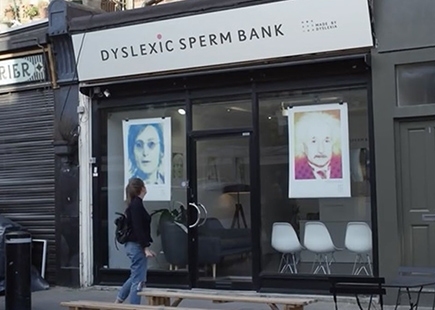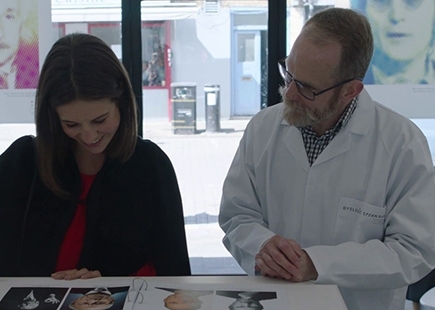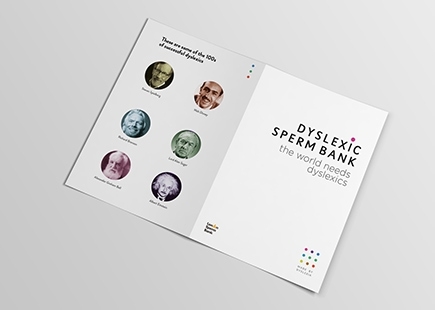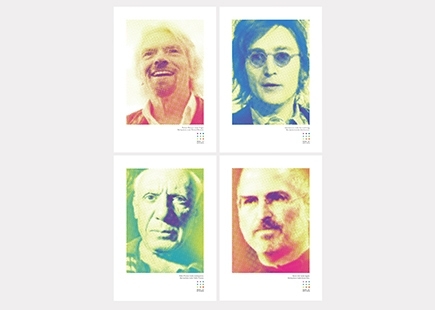ICYMI: The Dyslexic Sperm Bank

The Background
Having once again ventured deep into Google to look at old campaigns, the next ICYMI isn't particularly old as it goes but may have passed some by.
A really smart idea from 2017 and the Richard Branson backed Made by Dyslexia not-for-profit, who set about launching the world's first Dyslexic Sperm Bank.
The Big Idea
'Made for Dyslexia' is a charity aimed at redefining how dyslexia is viewed in the UK.
Born out of a need for a launch moment, the team were clearly looking for a fame-driving bit of creativity that would grab attention and get the word out. Something that would capture the key concept at the heart of the charity that would effectively communicate that far from being a disability, the dyslexic mind sees the world differently and often solves problems others can't, through a unique and distinctly lateral approach.
However, with age-old stereotypes persisting and 80% of the population in the UK still seeing dyslexia as a handicap, the issues surrounding it were very real.
School children still going undiagnosed, a stigma of dyslexia being shorthand for stupidity and a wholly negative view that was in need of reassessment.
So, to successfully launch this charity they needed to both find a way to appeal to the masses, create a debate, and turn stereotypes on their heads.
Which is exactly what they did.


What They Did
It's hard to believe but until around 2015, such was the view of dyslexia as a pernicious 'neurological disease' that some sperm banks in the UK would regularly turn people with dyslexia away.
This shocking fact that offered a perfect catalyst for the Made for Dyslexia team to set about launching the world's first Dyslexic Sperm Bank.
Setting up shop in a pop-up retail unit in the centre of London, the location was totally transformed to ape the appearance of one of those warm and inviting drop-in style private medical centres. Rigged with hidden cameras and featuring a bespectacled doctor in a white coat behind the front desk, walls surrounded the space in which curious artworks of famous faces added a bit of colour to the white minimalist interior.
Appearing overnight and open to the public for around three days, the Dyslexic Sperm Bank naturally caught the attention of a range of intrigued passers-by. Each doing a double-take and slowly plucking up the courage to walk through the front door, the look of intrigue and slight bewilderment apparent on their faces.
With each warmly met and engaged in conversation, the onsite doctor calmly answered questions and ushered them through to look at the catalogue of faces in a laminated ring binder where the likes of Albert Einstein, Henry Ford, Steve Jobs, Leonardo da Vinci and The Wright Brothers featured through the pages.
Mirroring each of the artworks on the walls, everyone in the catalogue achieved great things because they saw the world in the way they did. Each one of them dyslexic.
Reactions and conversations edited into a short video in which content spliced with a cutaway to a leafleteer drumming up business by asking increasingly shocked and angry passers-by if they were interested in having a dyslexic baby the emotional impact is real.
Watching as people flick through the binders and the conversations move from confusion to the dawning realisation that their own view of dyslexia has just changed in front of the viewers' eyes.
Very simple and exquisitely effective, you can physically see barriers coming down.
A beautiful thing to capture on-screen.


The Results
Aiming to build awareness by creating debate, they did exactly that and in glorious fashion across editorial and social.
Bagging a few thousand video views, multiple shares, and coverage across the nationals and meaty broadcast pieces on the BBC News, The Today Programme and Good Morning Britain.
Not
least supported by the might of founder and dyslexic Richard Branson,
results sited by the agency are rather impressive – reaching 77 million
people and directly generating a positive upswing in tweets referencing
dyslexia to the tune of 66%. Not quite sure how you measure such things,
but it did a job.
The Review
Impressive results and the build was great, but this was really all about the content and the human-interest stories at the heart of the campaign.
The simplicity in how the central premise and insight was delivered, coupled with the boldness in which Made for Dyslexia and Y&R attacked the stigma head-on gave creative license to capture, on film, the genuinely heart-warming piece of public reaction that draws you in and can't help but resonate.
The universal feeling of at first complicity and ultimately warmth makes this more than the sum of its parts in making us, first of all, think and then feel something about a topic that barely registered on our radar.
In Hindsight
It's a great concept and did exactly what it set out to do.
However, the one glaring omission for a campaign aimed at targeting inequality is the seeming lack of female faces in the famous dyslexic call sheet.
Potentially a sign of the times and how far we have come (and must go) but it wasn't that long ago.
Not least as they could have had their pick from the likes of Agatha Christie, Keira Knightley, Whoopi Goldberg, Erin Brockovich or a myriad of others across arts, sciences and entertainment industry and that's just for starters.
If you enjoyed this article, you can subscribe for free to our weekly email alert and receive a regular curation of the best creative campaigns by creatives themselves.
Published on:


